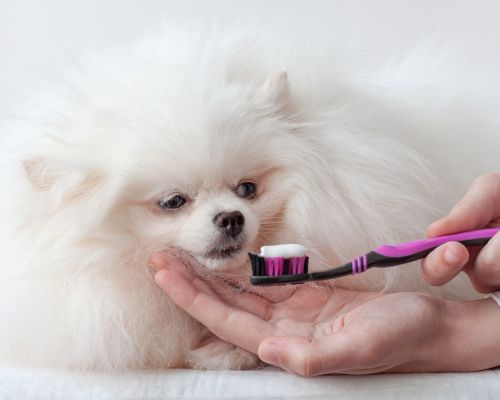Pet Small Animal Dentistry
Learn more about our pet small animal dentistry services below.
Pet Small Animal Dentistry
During your companion’s annual physical, our team will assess your pet for dental (periodontal) disease.
Pet Small Animal Dentistry
Dental disease is one of the most common medical conditions we see. It occurs when the accumulation of plaque and tartar results in gum recession and/or infection of the gums, tooth socket, and occasionally surrounding bone. Those of us that have had a toothache can relate to how painful dental disease can be! Since dental disease can affect other organs in the body, such as the heart, liver, and kidneys, we want to ensure we keep our companions’ mouths healthy.
Once tartar accumulates, professional dental scaling and polishing under general anesthesia will be necessary to remove the tartar and address the underlying infection. During the procedure, dental radiographs (X-rays) will be performed to evaluate the health of the teeth and surrounding bone. Severely diseased teeth may need to be extracted (removed) in order to re-establish a healthy mouth and help our pets become pain-free. Pain medication is provided to all patients who have undergone extractions to help them recover quickly from the procedure. Afterward, our team will work closely with you to formulate a plan to help minimize tartar accumulation and promote dental health.
We understand that anesthesia and surgery can evoke a very emotional response in a pet parent’s heart. While anesthesia, unfortunately, carries a small risk, we do everything possible to ensure your pet’s safety during a dental procedure.
We start with a thorough pre-operative physical examination and bloodwork to ensure no pre-existing conditions are present. We tailor every anesthetic protocol to each patient based on weight, age, concurrent disease, and procedure being performed—there is no “one size fits all” approach.
Our expert technicians place an intravenous (IV) catheter, and IV fluids are started. This allows us to ensure proper hydration and maintain our patient’s blood pressure while they are under anesthesia. During the dental procedure, your companion’s blood pressure, heart rate, temperature, and oxygenation levels are continually monitored and recorded by a highly trained nurse anesthetist. Should even the smallest changes in these parameters be noted, immediate changes to the anesthetic protocol are implemented to correct them. This strict monitoring is continued until your companion is completely recovered from anesthesia.

